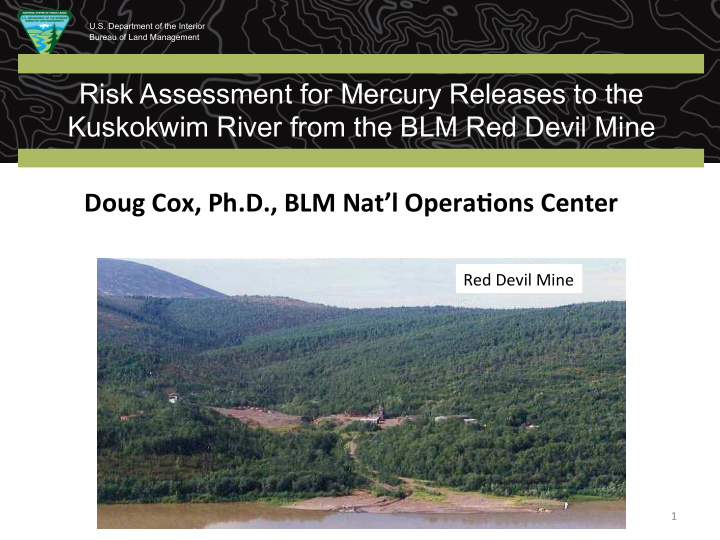



U.S. Department of the Interior Bureau of Land Management Red Devil Mine Risk Assessment for Mercury Releases to the Kuskokwim River from the BLM Red Devil Mine Doug Cox, Ph.D., BLM Nat’l OperaDons Center Red Devil Mine 1
U.S. Department of the Interior Bureau of Land Management PresentaDon OrganizaDon • PART 1: Site seGng and the Kuskokwim River Ø History of mercury mining acDviDes • Summary of Relevant Site InvesDgaDons • PART 2: Fish telemetry and Dssue study Ø (Presented by Dr. Angela Matz) • PART 3: Human health Risk Assessment Issues Ø MulDple lines of evidence Ø Supplemental RI risk assessment approaches Ø Overview of findings 2
U.S. Department of the Interior Bureau of Land Management IntroducDon and Project Overview • Mercury and other chemicals from Red Devil Mine and regional mineralized zones are present in Kuskokwim River sediment and biota • The methylaDon of mercury and food chain biomagnificaDon can impact upper food chain organisms, such as pike and burbot Concerns about human health risk (esp. subsistence) from Ø consumpDon of contaminated fish • This presentaDon describes a “MulDple Lines of Evidence” approach to integrate a number of relevant findings into risk management decision making 3
Kuskokwim River • Drains much of southwest AK • Ninth largest river in North America • Average discharge is 67,000 cfs • MulDple large tributaries
U.S. Department of the Interior Bureau of Land Management Kuskokwim River Adjacent to Red Devil June 2015 Linear shorelines High Turbidity Strong current Few shoreline wetlands 5
U.S. Department of the Interior Bureau of Land Management Important Site Issues Related to RDM and the Kuskokwim River • Numerous mercury deposits and mines across region • Elevated background mercury in mineralized zone • Fish are important local source of protein for subsistence peoples • Mercury detected in resident fish across region and Kusko watershed 6
U.S. Department of the Interior Bureau of Land Management Brief OperaDonal History of Red Devil Mine • Mercury mine (cinnabar ore) operated intermiFently from 1933-1971, depending on market price • Red Devil Mine produced nearly 87% of all mercury from Alaska (1,330 Tons) • Most of the mining was underground, with later phases including open pit mining • Mining, milling, retorDng, chemical storage, and waste disposal all done on-site • Tailings and retort waste disposed of on-site, used as fill, and dumped in Red Devil Creek – Pushed out into the Kuskokwim River 7
U.S. Department of the Interior Bureau of Land Management Historic Ore Processing Area, Red Devil Mine (buildings already removed) Kuskokwim River 8
U.S. Department of the Interior Bureau of Land Management Red Devil Creek SeFng Kuskokwim River 9
U.S. Department of the Interior Bureau of Land Management Current Status of Red Devil Mine Site • Site is abandoned, leaving BLM to conduct invesDgaDon and cleanup acDviDes • Viable PotenDally Responsible Party (PRP) not idenDfied • BLM demolished buildings, removed fuel tanks, and buried materials in on-site monofills in early 2000s • Red Devil village nearby; no other industrial faciliDes in the area 10
U.S. Department of the Interior Bureau of Land Management Current Status of Red Devil Mine Site • BLM iniDated RI/FS in 2009; RI completed in 2014 Ø Focused on groundwater and upland seGng Ø Did not fully address Kuskokwim River • Supplemental RI currently underway Ø AddiDonal Kuskokwim River data collected • Supplemental Human Health and Ecological Risk Assessment in development – Ecological risk not a topic of today’s presenta/on 11
U.S. Department of the Interior Bureau of Land Management Early AcDon at Red Devil Mine Monofills, Tailings StabilizaDon 12
U.S. Department of the Interior Bureau of Land Management PresentaDon OrganizaDon • PART 1: Site seGng and the Kuskokwim River Ø History of mercury mining acDviDes • Summary of Relevant Site InvesDgaDons • PART 2: Fish telemetry and Dssue study Ø (Presented by Dr. Angela Matz) • PART 3: Human health Risk Assessment Issues Ø MulDple lines of evidence Ø Supplemental RI risk assessment approaches Ø Overview of findings 13
Recommend
More recommend